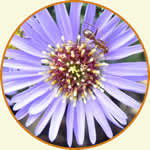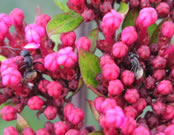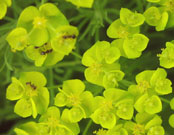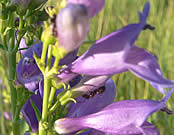USDA Forest Service Celebrating Wildflowers
|
|
|
Ant PollinationAnts form a great group of social insects that are great lovers of nectar. These busy insects are often observed visiting flowers to collect energy rich nectar. Ants are wingless and must crawl into each flower to reach their reward. Ants are more likely to take nectar without effectively cross-pollinating flowers. Researchers have discovered that some ants are not important pollinators, even though they visit flowers and may have pollen grains attach to their bodies. These scientists discovered that some ants and their larvae secrete a natural substance that acts as an antibiotic. This secretion protects ants from bacterial and fungal infections. Unfortunately for the flowers which are visited by these ants, this secretion also kills a pollen grain very rapidly when it comes in contact with this natural antibiotic. Ants visit inconspicuous, low-growing flowers positioned close to the stem. Examples of ant-pollinated plants in North America include Small's stonecrop (Diamorpha smallii), alpine nailwort (Paronychia pulvinata), and Cascade knotweed (Polygonum cascadense). Ant FlowersThe flowers that are visited by ants are typically:
For More InformationFun FactMany tropical plants have nectar outside of the flowers to attract ants. These plants rely on the defensive capabilities (biting and stinging) of the ants to protect them from various kinds of attack from other insects including nectar robbers. Many tropical plants have floral structures that make it difficult for bees and other pollinators to access internal nectar. Thus, it is tempting for such insects to simply pierce the flowers from the outside. Plants that secrete nectar on the outside of the flower and on their leaves have “ant-guard” system that prevents other insects from robbing nectar. These plants apparently have a chemical deterrent to keep the ants from entering the inside of the flower while rewarding them for protecting the outside of the flower. |
|
| Ants | Bats | Bees | Beetles | Birds | Butterflies | Flies | Moths | Unusual | Wasps | Wind & Water | |
| NOTE: PDF format links require the Adobe Acrobat Reader to view. | |
| top | Disclaimers | FOIA | Privacy Policy | Quality of Information | Photo Credits & Use |
Location: http://www.fs.fed.us/wildflowers/pollinators/ants.shtml
Last modified: Wednesday, 03-Sep-2008 14:28:24 EDT



